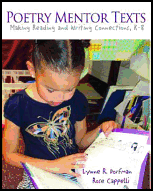Inspire Student Writers & Poets
Poetry Mentor Texts: Making Reading and Writing Connections, K-8
By Lynne R. Dorfman and Rose Cappelli
(Stenhouse Publishers, 2012 – Learn more)
As poet and writing teacher Georgia Heard writes in the foreword, Lynne Dorfman and Rose Cappelli have done it again! The co-authors of Mentor Texts and Nonfiction Mentor Texts have provided another “must have” resource for teachers of all disciplines.
In their first two books, Dorfman and Cappelli demonstrated how teachers can use children’s literature to guide and inspire student writers of fiction and nonfiction. They strongly believe that allowing students to study and imitate mentor texts not only provides them with quality writing models but encourages them to take risks in developing their own craft of writing and voice.

As a veteran teacher, I prided myself on being a “poetry teacher.” After all, we memorized poems, tried to figure out what they meant, and even devoted a unit to the study of poetry. Haiku, limericks, color poems and fill-in-the-blank poems were just a few types we explored. However, it wasn’t until I started reading this book that I discovered the true magnetic force of the written word.
What’s inside Poetry Mentor Texts
Navigating through the first two Mentor Text books was a delight. The latest is no different. Poetry Mentor Texts is research based and filled with delightful anecdotal stories, samples, charts, and guided lessons. The book includes mentor texts that focus on student-friendly poetic forms, such as list poems, acrostic poems, persona poems and poem for two voices. Lynne and Rose teach us to utilize the mentor poems to introduce craft and writing traits such as word choice, point of view, visualizing, and figurative language.
As I reviewed the book, I was impressed with quality of the sample lessons and interdisciplinary approach to teaching poetry. Many of their sample poems introduce the students to grammar and parts of speech in such an interactive way that the students don’t realize it. What better way to use this poem than for a shared reading activity, finding examples of internal rhyme such as “She dreams in reams” and end-rhyme pairs such as “trunk” and “chipmunk” and “sleeves” and “leave.”
The Winter Tree
The winter tree
is fast asleep.
She dreams, in reams
Of snow knee-deep.
Of children climbing up her trunk,
Of white-tailed deer
And gray chipmunk,
Of picnics,
Hammocks,
And short sleeves,
And leaves
And leaves
And leaves
My copy of the book resembles a multi-colored Post It Note ad. I found resources to use for formative assessments, such as having the students write astronomy persona poems as an exit slip, create list poems to challenge them to use more “sophisticated vocabulary words” (I borrowed the phrase from one of my fifth grade students), and use compare and contrast poems for two voices while teaching persuasive writing.
The lessons at the end of each chapter are extremely helpful and easily adapted to use with any grade level (the book’s suggested grade range is k-8). Each lesson follows the Gradual Release of Responsibility model — scaffolding the instruction and moving the lesson from teacher-centered, whole group delivery to student-centered collaboration and independent practice. In addition, each lesson encourages the students to reflect on how the strategy worked for them and how they could apply this strategy in the future.
Mentor text recommendations
Teachers are often overwhelmed with the plethora of books for children that are published each year. Of special assistance is a list at the end of each chapter of recommended books that the authors believe will serve as appropriate mentor texts.
Because many adults had negative experiences with poetry in their academic days, teachers often are reluctant to incorporate this literary form into the class. As Francis Degnan has written: “If you are to leave your children with the wonderful gift of an appreciation of poetry, you must allow yourself to get caught up in its magic.” Teachers need to play with poetry, and so do children. Writing poetry gives the child a chance to become a nonconformist in the world of language rules and regulations. It gives the child a chance to say, “What I feel counts!”
Give yourself and your students a chance to experience the sense of wonder words can create — the joy of writing poetry, the feeling of accomplishment as they explore the craft of poets and become mentor poets themselves.
“We don’t read and write poetry because it’s cute. We read and write poetry because we are members of the human race. And the human race is filled with passion. And medicine, law, business, engineering, these are noble pursuits and necessary to sustain life. But poetry, beauty, romance, love, these are what we stay alive for.” – Dead Poet’s Society
Linda Biondi is a fifth grade teacher at Pond Road Middle School in Robbinsville, New Jersey, and a Teacher Consultant with the National Writing Project.



































